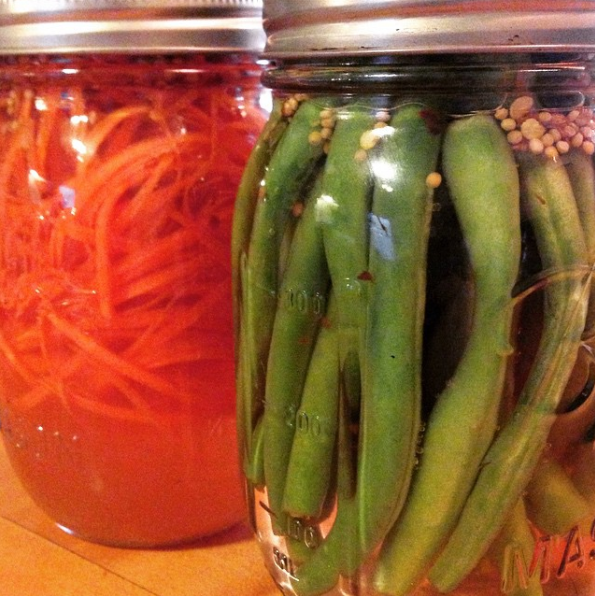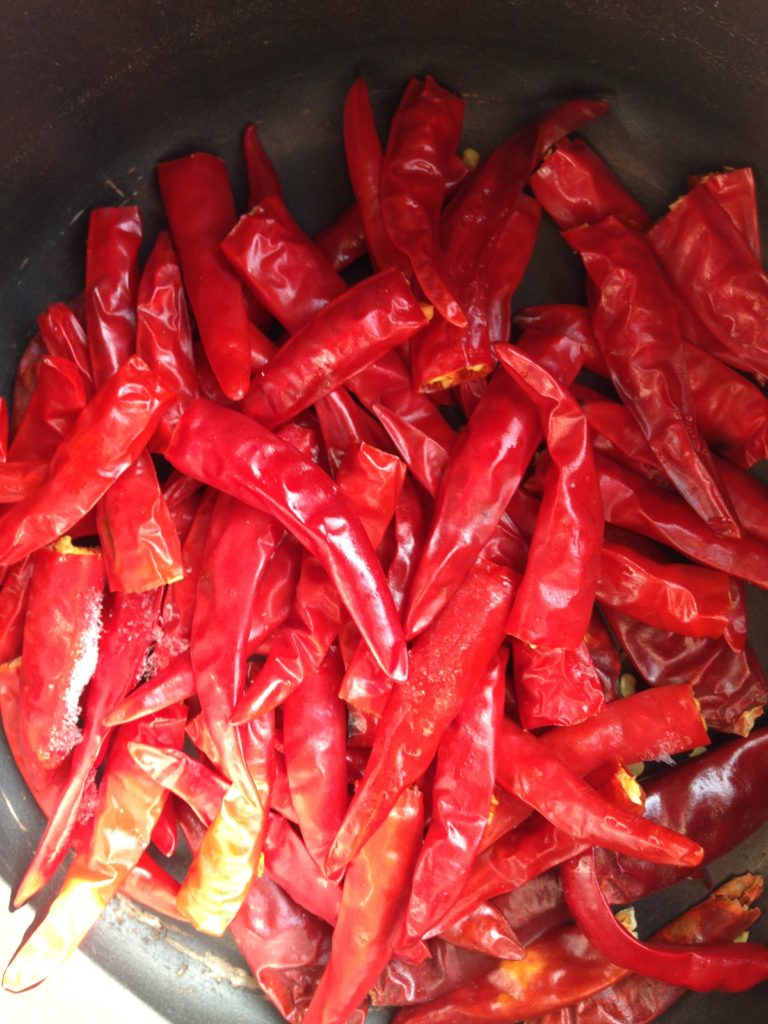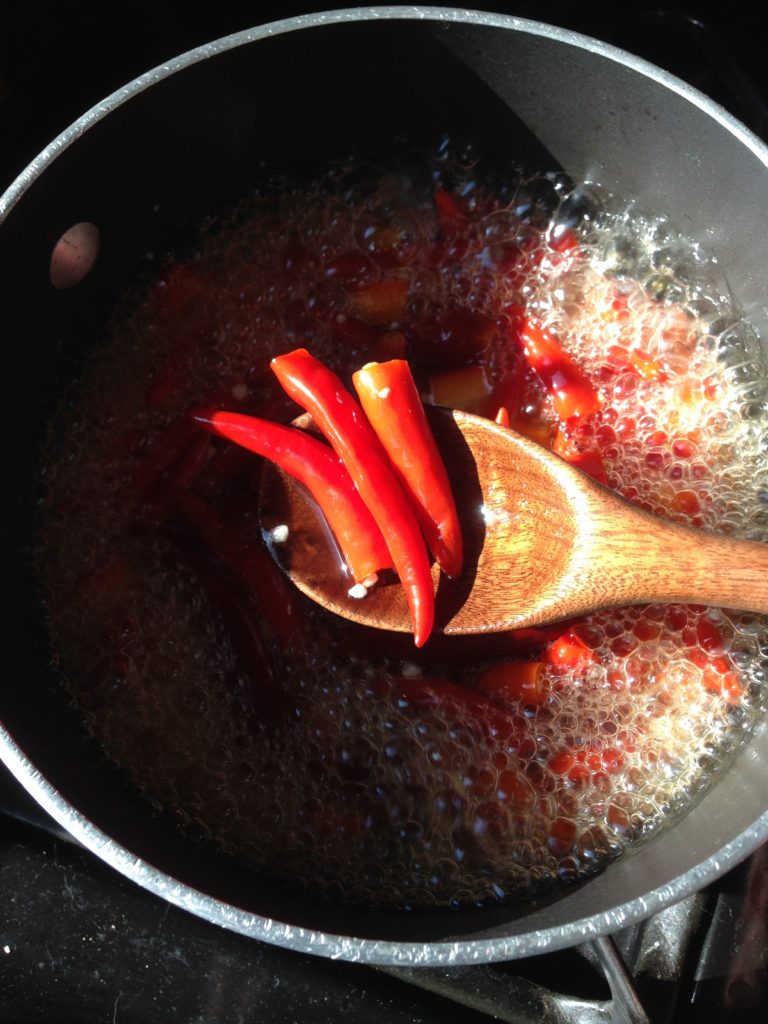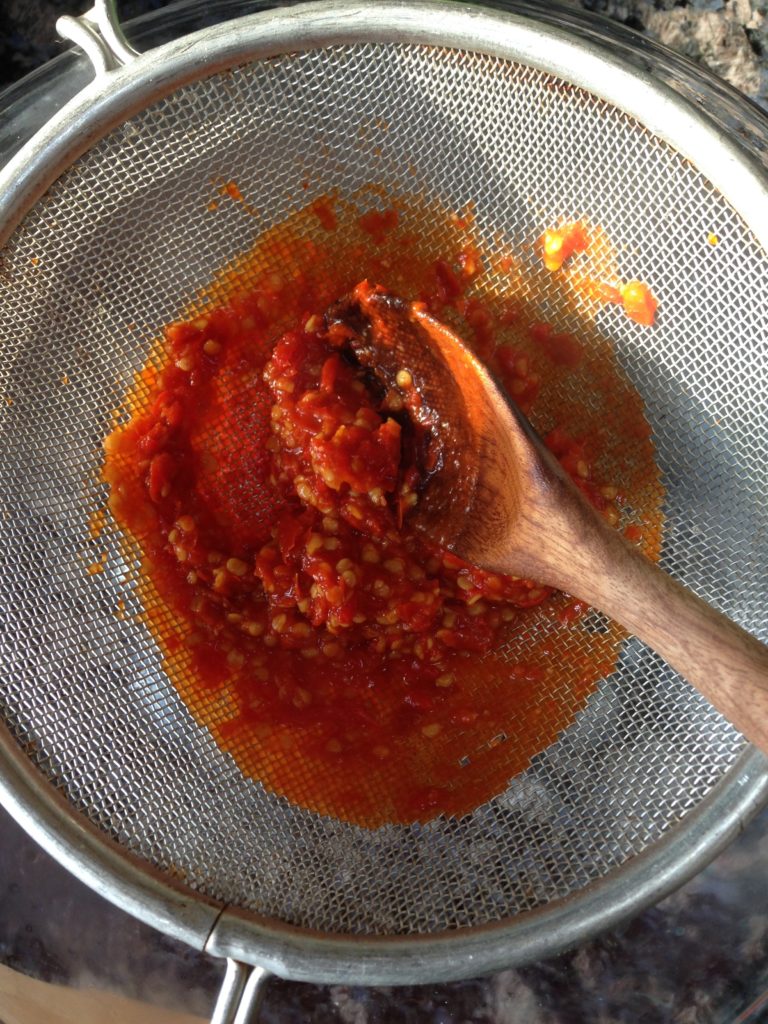
Category: food
Weekend project: homemade Sriracha (-ish)
Chilies + vinegar + garlic = something I really hope Dan will eat, because it’s way too spicy for me.
I’ve had “make homemade Sriracha” on my life list for four years, which is weird because I don’t actually eat very much Sriracha—I put a little in phở or tomato soup now and then, but I’m not the type to slather it over everything (I made that mistake the first time I ever ate it, using it like salsa on top of a bowl of rice and beans and nearly burning my face off). Now I actually wince when I see people squirting more than a dab on top of eggs or into a burrito.
A New York Times article on homemade hot sauces burrowed itself into my thoughts nonetheless, though, which is why I found myself stirring a boiling pot of chilies today while trying not to breathe in too many vinegar fumes.
A ton of recipes exist for homemade Sriracha, ranging from a Paleo version with jalapeños and honey to a fermented version using xanthan gum for thickening. Some need a week of fermentation, others a few days in the fridge to let the flavors meld, and others are ready to go as soon as they’re cool.
Given the amount of variation in these recipes—fresh fresnos, red and green jalapeños, ground habañeros, bell peppers, dried anchos—I figured I’d be good using a bunch of Thai chilies that have been hanging out in my freezer for a while, a handful of dried chilies (type unknown) I discovered in my cabinet, and half a red bell pepper I found in my fridge. Rather than measure or weigh them and use an actual recipe, I decided to wing it:
Step one: break or chop off the stem end of the chilies and chop the bell pepper. I ended up with around a cup and a half of loosely packed chilies and around a cup of chopped bell pepper. Add to a saucepan with enough water to cover.

Step two: Add a few chopped cloves of garlic, around half a tablespoon each of sugar and smoked salt, and a healthy pour of apple cider vinegar (around a quarter of a cup, maybe?). Bring to a boil, and keep there for around 25 minutes, or until all chilies and peppers can be easily mushed (technical term) with the back of a spoon.

Step three: attempt to blend with an immersion blender; splash hot chili juice over yourself and your computer. Regroup; scrape everything into a food processor and process until no chunks of pepper remain.
Step four: strain through a fine mesh sieve to remove seeds (not necessary—you could totally leave the seeds in, but I wanted to make sure I could squirt the sauce out of a regular Sriracha bottle without clogging the tip).

Step five: bottle (in a recycled Sriracha bottle, obviously) and taste. Burn face off, which is how you know it’s good…? I am not at all the right person to evaluate whether this is quality Sriracha or not, or whether there’s any nuance at all to the flavor, as I’m still drinking milk and trying to stop sweating.

Winter’s hard. So have some pancakes.
(Belated) Blog Action Day: Climate Change
 My post for last year’s Blog Action Day on poverty focused on my friend Halle’s fair trade organization in Uganda, One Mango Tree.
My post for last year’s Blog Action Day on poverty focused on my friend Halle’s fair trade organization in Uganda, One Mango Tree.
This year’s topic is climate change, and I’m equally excited to talk about the work another of my friends is doing. For the last six weeks I’ve been working with Global Voices on a project with MS Action Aid Denmark called Global Change.
Global Voices has paired its own bloggers — myself included — with students in the Global Change course, who have been studying climate change and climate justice in preparation for the United Nations Climate Change Conference in Copenhagen in December.
I met Sarah through the project: she’s a student in Copenhagen, and she’s leaving in a few days for Kenya with some other Global Change-ers, where the group will continue their studies and, hopefully, bring back stories of how climate change is affecting people’s lives there.
Today Sarah and her colleagues are in front of the Danish Parliament, where they’re observing World Food Day by banging pots and pans to, in Sarah’s words, “get the politicians to pay attention to the fact that 1 billion people are suffering from hunger right now.”
It can be easy to forget that climate change is about more than trees and cuddly animals and fish swimming around in some distant ocean — all of which I care about, don’t get me wrong (especially the cuddly animals). But climate change also has real, physical effects on humans: it’s altering weather patterns in unpredictable ways, causing crops to fail for lack of rain in some places while floods wash away entire fields in others.
Climate change is one of the driving forces behind the world food crisis, which, as Sarah pointed out, affects a substantial portion of the world’s population.
To sum up: Climate change. It’s not just koalas.
Kudos to Sarah and the entire Global Change crew for realizing this.
Hunger turns to anger: a priority of the United Nations?
Tonight the United Nations Studies Program at Columbia’s School of International and Public Affairs is hosting a panel on the world food crisis titled “Hunger turns to anger: a priority of the United Nations?” Jeffrey Sachs, UN Under-Secretary-General Thoraya Ahmed Obaid, UN Under-Secretary-General of Humanitarian Affairs Sir John Holmes, and International Federation of Agricultural Producers President Ajaykumar Manubhai Vashee are presenting. I’ve been tapped to cover the event for The Morningside Post, but I’ll also be liveblogging below:
